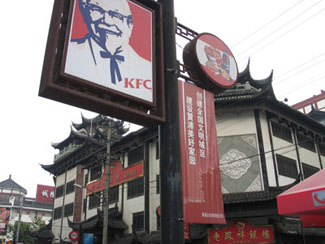A major shift in China’s economy should benefit KFC, McDonald’s, Starbucks and other foodservice brands beginning to regain their momentum in that country, according to a new report from Bernstein Research.
Western companies — including Yum! Brands Inc., McDonald’s Corp. and Starbucks Corp. — did not have an easy time in China in 2013, as the country’s once-skyrocketing economic growth continued to slow to a plateau in the high-single-digit-percent range. Yum’s KFC in particular, and to a lesser extent McDonald’s, also lost significant sales last year when Chinese consumers dealt with new concerns over the safety of the poultry supply and a new outbreak of avian flu.
RELATED
• Yum pledges 2014 recovery for KFC in China
• Focus Brands International president outlines China re-entry
• More restaurant international news
However, Bernstein’s restaurant industry analyst Sara Senatore wrote in a recent research note, China has begun the long process of moving its economy away from depending solely on manufacturing, exports and infrastructure development and more toward services and consumer spending. The transition would bode well for many American firms in China, especially restaurants, she noted.
“Longer term, we believe a consumption- and services-based economy would be a positive development for our companies,” Senatore wrote. “While the transition is likely to be bumpy, we do believe it will happen and see some signs that it is occurring.”
Bullish on opportunity in China

China’s growth in real gross domestic product reached a peak of about 12 percent in the first quarter of 2010 but has since leveled out to a range between 7 percent and 8 percent the past several quarters, Bernstein Research found.
Economists have concerns about the growth potential for China’s economy over the next several years, Senatore noted, citing projections that capital expenditures will decrease for Chinese firms, a moderation in the construction of new buildings and softness in indicators for hiring.
Yet among many companies Bernstein covers, including Yum, Starbucks and McDonald’s, the leaders of those firms are optimistic about the long-term expansion of China’s middle class of consumers.
“Remember, Yum currently has four restaurants per 1 million people in China, where the consuming class is expected to grow from 300 million [today] to over 600 million people by 2020,” Yum chief executive David Novak said during the Louisville, Ky.-based company’s fourth-quarter earnings call. “This compares to about 60 restaurants per million people in the United States with a consuming class of about 300 million people today. Clearly, we are in the early innings of growth [in China].”
In China, private consumption is a relatively much smaller part of the country’s nominal GDP, at only 36.1 percent, compared with 68.5 percent of GDP in the United States and 60.8 percent of GDP in Japan. However, China’s portion of the economy driven by consumer spending is projected to reach nearly 50 percent by 2033.
“For quick-service restaurants, generally the second rung on the away-from-home ladder after local independents,” Senatore wrote, “growth at the lower income levels of the consuming class would be promising.”
She added in her note that digital technology would be a major driver of growth in China for Yum and Starbucks. Yum already derives 70 percent of delivery orders in China from online ordering, which will grow further as its brands advance their mobile-ordering platforms. Starbucks launched its Starbucks Rewards program in China two years ago, and already the platform has 4 million members.
Senatore noted that officials for McDonald’s and Burger King have pointed to their expanded value offerings, including dessert kiosks for McDonald’s, as essential to driving traffic and sales in China.
Gunning for No. 1 outside Tier 1 markets
Senatore added that Bernstein Research remained optimistic about Yum’s, McDonald’s and Starbucks’ long-term prospects in China because they have scale advantages over local competitors, even in fast-developing markets outside the Tier 1 and Tier 2 cities on China’s coasts like Shanghai and Beijing.
“Given the still aspirational nature of western QSRs in lower-tier cities and the coffee specialist for even more affluent customers, we believe rising income and a shift toward consumption bodes well over the long term,” she wrote.
Bernstein expects Yum’s growth in same-store sales to outpace inflation in China in 2014, especially as it laps last year’s sales figures that were yoked to the negative PR surrounding consumer fears about avian flu and the poultry supply, Senatore wrote.
“If input costs remain modest, we could see material margin expansion on these ‘catch-up’ comps,” she wrote.
Yum’s scale advantage in Tier 3 through Tier 6 cities in China’s interior provinces, particularly for KFC, should be a “tailwind” relative to McDonald’s and should help drive overall profit margins when blended with growth expected in Tier 1 and Tier 2 coastal cities, she added.
KFC locations in lower-tier cities have a 19-percent cash margin, compared with KFCs in Tier 1 and Tier 2 cities that have 11-percent cash margins, while the $1.1 million average unit volume is the same across China, Bernstein estimated. KFC has more than four times as many restaurants as McDonald’s does in the interior cities, with 2,151 units, compared with 510 units for McDonald’s.
Contact Mark Brandau at [email protected].
Follow him on Twitter: @Mark_from_NRN

